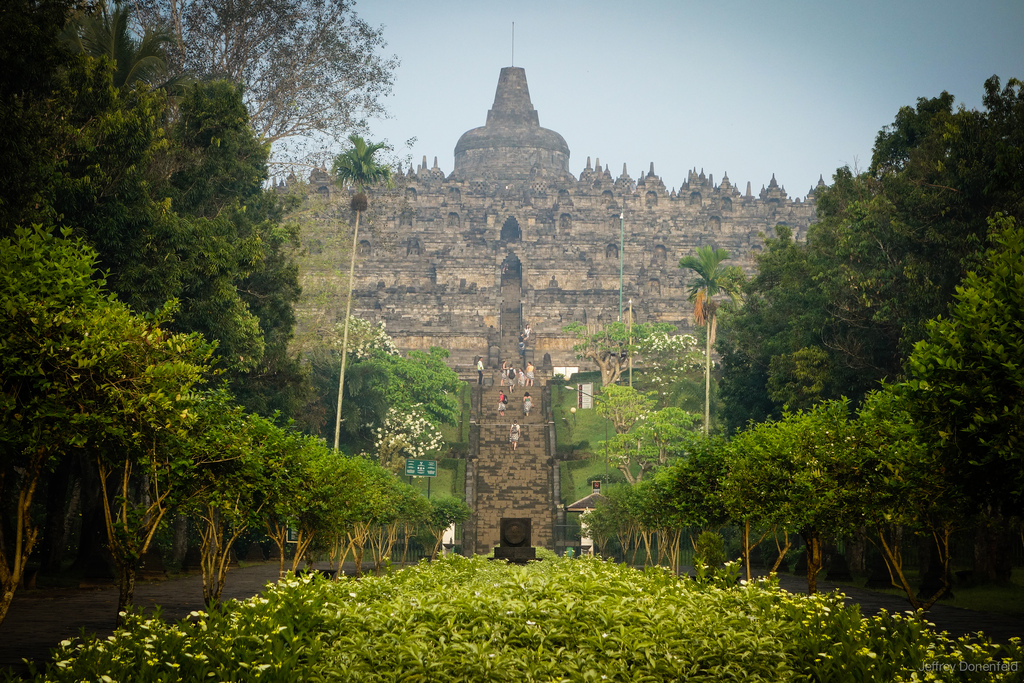After an early morning sunrise on Mt. Ijen and another at Mt. Bromo, Jan and I decided to continue the trend and go for a 3rd sunrise at the ancient Mahayana Buddhist Temple of Borobudur.
A bit on Borobudur, from Wikipedia:
Borobudur, or Barabudur, is a 9th-century Mahayana Buddhist Temple in Magelang, Central Java, Indonesia. The monument consists of six square platforms topped by three circular platforms, and is decorated with 2,672 relief panels and 504 Buddha statues.[1] A main dome, located at the center of the top platform, is surrounded by 72 Buddha statues seated inside a perforated stupa.
Built in the 9th century during the reign of the Sailendra Dynasty, the temple’s design in Gupta architecture reflects India’s influence on the region. It also depicts the gupta style from India and shows influence of Buddhism as well as Hinduism.[2][3] The monument is both a shrine to the Lord Buddha and a place for Buddhist pilgrimage. The journey for pilgrims begins at the base of the monument and follows a path around the monument and ascends to the top through three levels symbolic of Buddhist cosmology: K?madh?tu (the world of desire), Rupadhatu (the world of forms) and Arupadhatu (the world of formlessness). The monument guides pilgrims through an extensive system of stairways and corridors with 1,460 narrative relief panels on the walls and the balustrades.
Evidence suggest Borobudur was constructed in the 9th century and abandoned following the 14th century decline of Hindu kingdoms in Java, and the Javanese conversion to Islam.[4] Worldwide knowledge of its existence was sparked in 1814 by Sir Thomas Stamford Raffles, then the British ruler of Java, who was advised of its location by native Indonesians. Borobudur has since been preserved through several restorations. The largest restoration project was undertaken between 1975 and 1982 by the Indonesian government and UNESCO, following which the monument was listed as a UNESCO World Heritage Site.[5] Borobudur is still used for pilgrimage; once a year Buddhists in Indonesia celebrate Vesak at the monument, and Borobudur is Indonesia’s single most visited tourist attraction.
Pics from our early morning visit:
Arriving at the temple early in the morning, a thick morning fog hung over the ancient stones.

All visitors to Borobudur are required to wear traditional Sarongs. Upon arriving at the end entrance gate, before going through security, one of the park rangers helps each guest put one on.
https://www.flickr.com/photos/jamfan2/8632367772/in/set-72157633193228871
As a still active temple, Borobudur draws in both tourists and worshippers, including these monks.

Intricate stone carvings adorn the entire structure. Considering how many times this monument has been robbed, bombed, lost, and destroyed, it’s still in incredibly good shape – thanks to an army of experts working on its constant maintenance and restoration.

The Stupas, Borobudurs hallmark feature point towards the heavens.



https://www.flickr.com/photos/jamfan2/8632354890/in/set-72157633193228871


Comments
2 responses to “Morning Fog At The Buddhist Temple of Borobudur”
Hi:)
Thankyou for showing the world how beautiful is Candi Borobudur.
I
[…] Morning Fog At The Buddhist Temple of Borobudur